Class definition for implementing the Hamming distance routine along with controlled Y rotations to encode the Hamming distance into the states' amplitudes. More...
#include <hamming.hpp>

Public Member Functions | |
| HammingDistance ()=delete | |
| Construct a new Hamming Distance Rot Y object (disabled) More... | |
| HammingDistance (const std::size_t len_bin_pattern_) | |
| Construct a new Hamming Distance Rot Y object. More... | |
| ~HammingDistance () | |
| Destroy the Hamming Distance Rot Y object. More... | |
Static Public Member Functions | |
| static void | computeHammingDistanceRotY (SimulatorType &qSim, const std::vector< std::size_t > ®_memory, const std::vector< std::size_t > ®_auxiliary, std::size_t len_bin_pattern) |
| Computes Hamming Distance; adjusts each state's amplitude proportional to the Hamming distance between the state's training pattern and the test pattern using rotations about y for each mattern qubit. More... | |
| static void | computeHammingDistanceOverwriteAux (SimulatorType &qSim, const std::vector< std::size_t > ®_memory, const std::vector< std::size_t > ®_auxiliary) |
| Computes Hamming Distance; Overwrites the pattern in reg_auxiliary to track bit differences from reg_memory. More... | |
Private Types | |
| using | Mat2x2Type = decltype(std::declval< SimulatorType >().getGateX()) |
Private Attributes | |
| std::size_t | len_bin_pattern |
Detailed Description
template<class SimulatorType>
class QNLP::HammingDistance< SimulatorType >
Class definition for implementing the Hamming distance routine along with controlled Y rotations to encode the Hamming distance into the states' amplitudes.
- Template Parameters
-
SimulatorType Class simulator type
Definition at line 26 of file hamming.hpp.
Member Typedef Documentation
◆ Mat2x2Type
|
private |
Definition at line 29 of file hamming.hpp.
Constructor & Destructor Documentation
◆ HammingDistance() [1/2]
|
delete |
Construct a new Hamming Distance Rot Y object (disabled)
◆ HammingDistance() [2/2]
|
inline |
Construct a new Hamming Distance Rot Y object.
- Parameters
-
len_bin_pattern_ Length of binary string which the Hamming distance is to be computed upon
Definition at line 45 of file hamming.hpp.
References QNLP::HammingDistance< SimulatorType >::len_bin_pattern.
◆ ~HammingDistance()
|
inline |
Member Function Documentation
◆ computeHammingDistanceOverwriteAux()
|
inlinestatic |
Computes Hamming Distance; Overwrites the pattern in reg_auxiliary to track bit differences from reg_memory.
- Parameters
-
qSim Quantum simulator instance. reg_memory A vector containing the indices of the qubits of the memory register. reg_auxiliary A vector containing the indices of the qubits of the auxiliary register.
Definition at line 102 of file hamming.hpp.
References QNLP_Python_MPI::reg_auxiliary, and QNLP_EndToEnd_MPI::reg_memory.
Referenced by QNLP::SimulatorGeneral< IntelSimulator >::applyHammingDistanceOverwrite().

◆ computeHammingDistanceRotY()
|
inlinestatic |
Computes Hamming Distance; adjusts each state's amplitude proportional to the Hamming distance between the state's training pattern and the test pattern using rotations about y for each mattern qubit.
- Parameters
-
qSim Quantum simulator instance. reg_memory A vector containing the indices of the qubits of the memory register. reg_auxiliary A vector containing the indices of the qubits of the auxiliary register. len_bin_pattern length of binary pattern ie length of memory register.
Definition at line 64 of file hamming.hpp.
References QNLP::HammingDistance< SimulatorType >::len_bin_pattern, QNLP_Python_MPI::len_reg_auxiliary, QNLP_Python_MPI::reg_auxiliary, and QNLP_EndToEnd_MPI::reg_memory.
Referenced by QNLP::SimulatorGeneral< IntelSimulator >::applyHammingDistanceRotY().

Field Documentation
◆ len_bin_pattern
|
private |
Definition at line 31 of file hamming.hpp.
Referenced by QNLP::HammingDistance< SimulatorType >::computeHammingDistanceRotY(), and QNLP::HammingDistance< SimulatorType >::HammingDistance().
The documentation for this class was generated from the following file:
- /Users/mlxd/Desktop/intel-qnlp-rc2/modules/hamming/hamming.hpp
